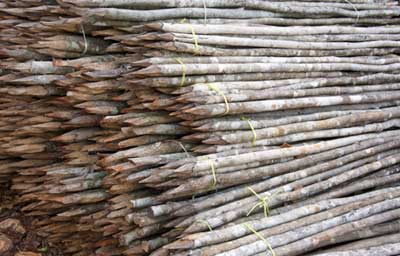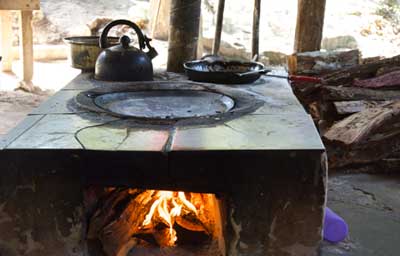Restauración forestal en áreas invadidas con helecho "Pteridium aquilinum"

Pteridium aquilinum (L.) Kuhn, (helecho, cilantrillo, crespillo, warkan, xtok’ xiw), es un helecho con distribución mundial que ha desarrollado una capacidad de supervivencia asombrosa, ya que una vez que coloniza un potrero o área agrícola es muy difícil de erradicar, el suelo prácticamente se inutiliza y los productores terminan por abandonar el área. La solución a este problema ha sido desde un inicio una de las inquietudes de la sociedad de productores denominada El Machich. Esta sociedad formada en el año 2002 por trece ejidatarios del ejido Laguna Om se focaliza en silvicultura, agroforestería y apicultura. El líder del grupo es Pedro A. Macario Mendoza, ejidatario e investigador de El Colegio de la Frontera Sur (ECOSUR) con larga trayectoria en el estudio ecológico en las etapas de sucesión del bosque. Dentro de las parcelas que maneja “El Machich”, Macario conduce sus investigaciones sobre crecimiento secundario, manejo de acahuales, enriquecimiento de la selva, y desde luego restauración forestal en áreas invadidas por el helecho, materia en la que se ha convertido en un referente. Situación inicial“En el año 1992, cuenta Macario mientras camina por un bosque que aparenta tener unas cuantas décadas, esto era 1 hectárea deforestada. Empezamos a hacer enriquecimiento de acahuales con caoba y cedro, y hoy los árboles ya tienen contrafuertes y un promedio de 30 cm de diámetro, es asombroso cómo han crecido”. “El enriquecimiento, explica, es para que el manejo de la selva secundaria sea económicamente viable, porque un metro cúbico de cualquier especie, llámese tzalam, chacah, etc., distinta a caoba, cedro o ciricote, actualmente en el mercado local se vende en 1,600 pesos, mientras que el costo total para extraer ese metro cúbico es de 1,500 pesos. Si enriquecemos con caoba o cedro el panorama cambia, porque el metro cúbico de esta especie tiene un precio actual de 5,000 pesos con el mismo costo de extracción de 1,500 pesos”. El enriquecimiento de acahual no es una plantación donde solo hay una especie, sino que se trata de plantar especies de valor dentro del bosque con crecimiento natural. De esta manera, y mientras enseña sus parcelas de 15, 21 y 29 años de crecimiento secundario, Macario cuenta cómo fueron los inicios de sus investigaciones sobre el enriquecimiento y el crecimiento diamétrico en el acahual.
Unos metros más adelante en el recorrido, Macario detiene su camioneta y cuenta, “esta selva en el año 2000 era un helechal, aquí empecé mis ensayos con el helecho, se puede ver el cambio que hubo en 15 años. Además de combatir el helecho, en este lote se hizo manejo de acahual y reforestación con cedro y caoba. Tenemos otro lote que está en el quinto año de restauración, y otro lote testigo. Esto es un islote de selva de 200 hectáreas rodeadas de helechal, las cuales alguna vez fueron milpa o potrero y hoy están en diferentes etapas de restauración (40, 29, 21, 15 y 5 años)”. Más adelante Macario enseña una selva remanente de 50 años, y señala un zapote con más de 100 años, un sobreviviente de la tala realizada en los años ‘70. “Esto es una muestra de lo que tiene que llegar a ser esta área de selva”, explica con la pasión de un gran profesor. “En este islote remanente encontramos árboles con más de 50 años, como jobo (Spondias mombin), zapote (Manilkara zapota), copal (Protium copal) y palmas como el guano kum (Cryosophila argentea) que es típico de la selva húmeda”. Macario argumenta que estas 200 ha, en acuerdo con “El Machich”, las han destinado para mostrar a sus compañeros del ejido y a quien se interese, que la restauración es posible y solo requiere de voluntad, asesoría y unos cuantos pesos, desde luego.
Se puede decir que el momento clave es cuando después de 15 años de haber iniciado con los tratamientos vemos que la restauración ha resultado y el helecho está controlado. “Esta parcela ya lleva 5 años sin quemarse (parcela testigo)”, menciona Macario mientras levanta un colchón de biomasa de helechos secos del suelo. “Esta otra también tiene 5 años sin quemarse (parcela con tratamiento), no hay tal volumen de material combustible y ya está empezando a dominar el monte”. Esa biomasa seca es muy combustible, pero el helecho tiene rizomas subterráneos que no mueren con el fuego, y en pocas semanas vuelve a rebrotar. Esa es su estrategia para dominar un ambiente, todo lo demás muere pero el helecho no. “Solo hay una cosa que inhibe el crecimiento del helecho, y es la sombra. Por eso si la vegetación crece, el helecho deja de crecer; no desaparece, pero deja de invadir. El problema es que la selva demora mucho en crecer, y los helechales se queman con mucha frecuencia, por eso dominan si no hay un tratamiento o intervención”.
La pregunta es ¿cómo acelerar el proceso de sucesión sin que gane el helechal? “En la literatura se puede encontrar algunos métodos de control que ya han sido probados, pero ninguno de ellos menciona el chapeo que es el que proponemos nosotros”, explica Macario. “El problema con los métodos clásicos de control es que todos asumen que después del combate al helecho vendrá agricultura es decir, un cambio de uso que incluye la restauración, por eso mencionan al arado y la rastra para exponer los rizomas al aire, o un rodillo para aplastar al helecho, otros mencionan herbicidas, pero esto no es bueno si lo que queremos es dejar que se regenere otra vez la vegetación”.
El tratamiento que propone Macario son chapeos constantes, y para su evaluación tiene parcelas con diferentes tratamientos: chapeo cada mes, cada dos meses, cada tres meses y desde luego un testigo sin chapeo. “El que más funciona es el que se realiza cada mes, porque el de cada tres meses es un período tan amplio que el helecho vuelve a recuperarse y se comporta casi igual que el testigo (área sin tratamiento). Pero lógicamente, el costo de mano de obra es el más elevado”. Macario también tiene estudiado el costo de la restauración, y es de 22,000 pesos por hectárea para un período de 10 años a contar del año de inicio. La mayor inversión es en el primer año con chapeos cada 15 días durante 3 meses, y cada 30 días los siguientes 9 meses. Del segundo al quinto año disminuye un poco la intensidad del tratamiento, y del quinto al décimo es sólo cuidar que no haya quemas en los meses de sequía. “Esta otra área de selva tiene 15 años de tratamiento, explica, y todavía se ven algunos helechos, solo se atenúa porque es un rizoma, pero no desaparece. Este lote pasó de helechal a acahual, y ahora es un bosque secundario enriquecido con cedro y caoba”. Es sorprendente, cuando se inicia con el tratamiento empieza a crecer el acahual con más de 40 especies forestales que colonizan. Eso quiere decir que el fuego no mata sus semillas ni sus partes vegetativas, sino que el helechal no los deja crecer, podemos pensar que estas especies ya se han “adaptado” a la incidencia del fuego. “Hoy podemos decir que ya tenemos claro el método de control del helecho Pteridium”, explica Macario. “Independientemente de la investigación, explica Macario, lo que estamos buscando es la manera de poder financiar nuevas áreas de restauración. En este momento estamos cuidando 50 hectáreas que tienen 5 años de tratamiento, es decir que desde ahora necesitan un tratamiento anual, pero esta etapa es crítica porque si se abandona, el helecho vuelve a invadir, aún no está lo suficientemente cubierto de sombra”. Macario con mucho orgullo y pasión cuenta: “a esta área restaurada (con 5 años de tratamiento) la vi ser un helechal desde hace casi 50 años, y muchas veces soñé con restaurarla. Ahora veo mi sueño hecho realidad, desde luego con el apoyo de mis compañeros de El Machich, de la Comisión Nacional Forestal, el Consejo Nacional de Ciencia y Tecnología y ECOSUR; que aportamos voluntad, asesoría y varios pesos. La misión aún no está cumplida, hace falta continuar hasta los 10 años y después iniciar otro largo camino para el aprovechamiento o manejo del área que es la lección que sigue”. “Legalmente no existe diferencia entre una selva madura, con gran aptitud forestal, y un acahual. Esto genera un incentivo perverso, dice Macario, porque el aprovechamiento de un acahual no es tan rentable como una selva bien manejada. Sin embargo, como un acahual de 10 años ante la ley ya es una selva, es necesario contar con inventario y planes de manejo que son muy costosos”. Ante este escenario, la opción más común entre los productores es tumbar y hacer milpa o potrero. “En Calakmul, explica, estamos haciendo un estudio técnico de manejo de acahual, y a la par estamos trabajando con especialistas para proponer una modificación en la ley forestal”. La voluntad para hacer una modificación existe, lo complicado está en definir qué es un acahual y en qué punto deja de serlo para pasar a considerarse una selva. Esta modificación podría marcar una gran diferencia en el uso del suelo, porque si se pudiera reducir los costos de aprovechamiento del acahual, en el tercer año ya se puede sacar beneficios y el productor tendría un incentivo para empezar a recuperar o restaurar la selva. De ser así, pasaría a ser económicamente viable la restauración de áreas forestales degradadas. |























